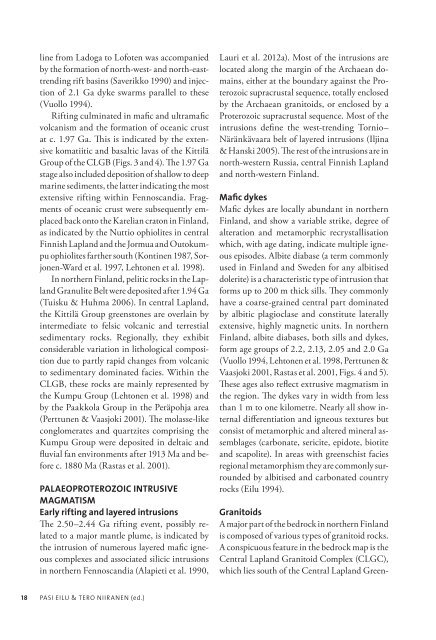Gold deposits in northern Finland - Arkisto.gsf.fi
Gold deposits in northern Finland - Arkisto.gsf.fi
Gold deposits in northern Finland - Arkisto.gsf.fi
Create successful ePaper yourself
Turn your PDF publications into a flip-book with our unique Google optimized e-Paper software.
l<strong>in</strong>e from Ladoga to Lofoten was accompanied<br />
by the formation of north-west- and north-easttrend<strong>in</strong>g<br />
rift bas<strong>in</strong>s (Saverikko 1990) and <strong>in</strong>jection<br />
of 2.1 Ga dyke swarms parallel to these<br />
(Vuollo 1994).<br />
Rift<strong>in</strong>g culm<strong>in</strong>ated <strong>in</strong> ma<strong>fi</strong>c and ultrama<strong>fi</strong>c<br />
volcanism and the formation of oceanic crust<br />
at c. 1.97 Ga. This is <strong>in</strong>dicated by the extensive<br />
komatiitic and basaltic lavas of the Kittilä<br />
Group of the CLGB (Figs. 3 and 4). The 1.97 Ga<br />
stage also <strong>in</strong>cluded deposition of shallow to deep<br />
mar<strong>in</strong>e sediments, the latter <strong>in</strong>dicat<strong>in</strong>g the most<br />
extensive rift<strong>in</strong>g with<strong>in</strong> Fennoscandia. Fragments<br />
of oceanic crust were subsequently emplaced<br />
back onto the Karelian craton <strong>in</strong> F<strong>in</strong>land,<br />
as <strong>in</strong>dicated by the Nuttio ophiolites <strong>in</strong> central<br />
F<strong>in</strong>nish Lapland and the Jormua and Outokumpu<br />
ophiolites farther south (Kont<strong>in</strong>en 1987, Sorjonen-Ward<br />
et al. 1997, Lehtonen et al. 1998).<br />
In <strong>northern</strong> F<strong>in</strong>land, pelitic rocks <strong>in</strong> the Lapland<br />
Granulite Belt were deposited after 1.94 Ga<br />
(Tuisku & Huhma 2006). In central Lapland,<br />
the Kittilä Group greenstones are overla<strong>in</strong> by<br />
<strong>in</strong>termediate to felsic volcanic and terrestial<br />
sedimentary rocks. Regionally, they exhibit<br />
considerable variation <strong>in</strong> lithological composition<br />
due to partly rapid changes from volcanic<br />
to sedimentary dom<strong>in</strong>ated facies. With<strong>in</strong> the<br />
CLGB, these rocks are ma<strong>in</strong>ly represented by<br />
the Kumpu Group (Lehtonen et al. 1998) and<br />
by the Paakkola Group <strong>in</strong> the Peräpohja area<br />
(Perttunen & Vaasjoki 2001). The molasse-like<br />
conglomerates and quartzites compris<strong>in</strong>g the<br />
Kumpu Group were deposited <strong>in</strong> deltaic and<br />
fluvial fan environments after 1913 Ma and before<br />
c. 1880 Ma (Rastas et al. 2001).<br />
Palaeoproterozoic <strong>in</strong>trusive<br />
magmatism<br />
Early rift<strong>in</strong>g and layered <strong>in</strong>trusions<br />
The 2.50–2.44 Ga rift<strong>in</strong>g event, possibly related<br />
to a major mantle plume, is <strong>in</strong>dicated by<br />
the <strong>in</strong>trusion of numerous layered ma<strong>fi</strong>c igneous<br />
complexes and associated silicic <strong>in</strong>trusions<br />
<strong>in</strong> <strong>northern</strong> Fennoscandia (Alapieti et al. 1990,<br />
Lauri et al. 2012a). Most of the <strong>in</strong>trusions are<br />
located along the marg<strong>in</strong> of the Archaean doma<strong>in</strong>s,<br />
either at the boundary aga<strong>in</strong>st the Proterozoic<br />
supracrustal sequence, totally enclosed<br />
by the Archaean granitoids, or enclosed by a<br />
Protero zoic supracrustal sequence. Most of the<br />
<strong>in</strong>trusions def<strong>in</strong>e the west-trend<strong>in</strong>g Tornio–<br />
Näränkävaara belt of layered <strong>in</strong>trusions (Ilj<strong>in</strong>a<br />
& Hanski 2005). The rest of the <strong>in</strong>trusions are <strong>in</strong><br />
north-western Russia, central F<strong>in</strong>nish Lapland<br />
and north-western F<strong>in</strong>land.<br />
Ma<strong>fi</strong>c dykes<br />
Ma<strong>fi</strong>c dykes are locally abundant <strong>in</strong> <strong>northern</strong><br />
F<strong>in</strong>land, and show a variable strike, degree of<br />
alteration and metamorphic recrystallisation<br />
which, with age dat<strong>in</strong>g, <strong>in</strong>dicate multiple igneous<br />
episodes. Albite diabase (a term commonly<br />
used <strong>in</strong> F<strong>in</strong>land and Sweden for any albitised<br />
dolerite) is a characteristic type of <strong>in</strong>trusion that<br />
forms up to 200 m thick sills. They commonly<br />
have a coarse-gra<strong>in</strong>ed central part dom<strong>in</strong>ated<br />
by albitic plagioclase and constitute laterally<br />
extensive, highly magnetic units. In <strong>northern</strong><br />
F<strong>in</strong>land, albite diabases, both sills and dykes,<br />
form age groups of 2.2, 2.13, 2.05 and 2.0 Ga<br />
(Vuollo 1994, Lehtonen et al. 1998, Perttunen &<br />
Vaasjoki 2001, Rastas et al. 2001, Figs. 4 and 5).<br />
These ages also reflect extrusive magmatism <strong>in</strong><br />
the region. The dykes vary <strong>in</strong> width from less<br />
than 1 m to one kilometre. Nearly all show <strong>in</strong>ternal<br />
differentiation and igneous textures but<br />
consist of metamorphic and altered m<strong>in</strong>eral assemblages<br />
(carbonate, sericite, epidote, biotite<br />
and scapolite). In areas with greenschist facies<br />
regional metamorphism they are commonly surrounded<br />
by albitised and carbonated country<br />
rocks (Eilu 1994).<br />
Granitoids<br />
A major part of the bedrock <strong>in</strong> <strong>northern</strong> F<strong>in</strong>land<br />
is composed of various types of granitoid rocks.<br />
A conspicuous feature <strong>in</strong> the bedrock map is the<br />
Central Lapland Granitoid Complex (CLGC),<br />
which lies south of the Central Lapland Green<br />
18 Pasi Eilu & Tero Niiranen (ed.)
















